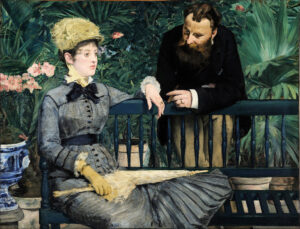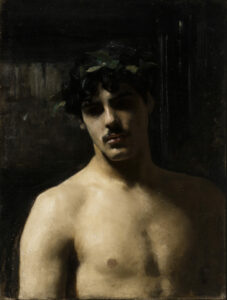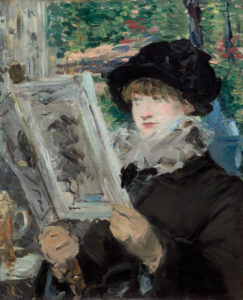
Paris, 1879. Édouard Manet immortalizes his friends, the Guillemet couple, in a luxuriant conservatory. She is seated, he stands behind her. Their hands rest on the back of the bench, not quite touching. A conversation suspended in a charged atmosphere.
An Intimate Scene
Manet composes a striking scene of distant proximity. The woman, dressed in a gray gown with tight buttons and wearing a yellow straw hat, gazes into the distance. The man leans toward her, cigar in hand. His index finger points toward the young woman, but the cigar prevents any contact. Their gestures remain suspended. Manet’s Impressionist brushwork brings the tropical foliage to life, filling the composition. The deep greens and delicate pinks of the flowers create a dense botanical setting.
An Unexpected Political Scandal
In 1896, Hugo von Tschudi purchased this painting for the Nationalgalerie in Berlin. This acquisition marked a renewal for the institution. But the canvas caused unease. In 1904, it was attacked in the Prussian Parliament. It was deemed suggestive, immoral. The tropical veranda evoked the licentious novels of the period. This sensual atmosphere scandalized German society of the time. Yet nothing explicit takes place. Just this unsettling proximity, this intimate conversation.
Manet, Painter of Modern Life
Édouard Manet (1832-1883) revolutionized 19th-century painting. He depicted the Parisian bourgeoisie without idealization. His direct style and free brushwork heralded Impressionism. Here, he represents the Guillемets, fashion merchants on rue Saint-Honoré, in the studio-conservatory of painter Georg von Rosen. Manet transforms a friendly portrait into an enigmatic scene.
Think about it
💭 What are they really saying to each other? Does this distance between their hands reveal the nature of their relationship, or simply the social conventions of their time?
About this work
- In the Conservatory
- Édouard Manet
- 1878-1879
- Staatliche Museen zu Berlin, Alte Nationalgalerie / Jörg P. Anders Public Domain
- Oil on canvas
- 115 x 150 cm
- https://id.smb.museum/object/962626/im-wintergarten






